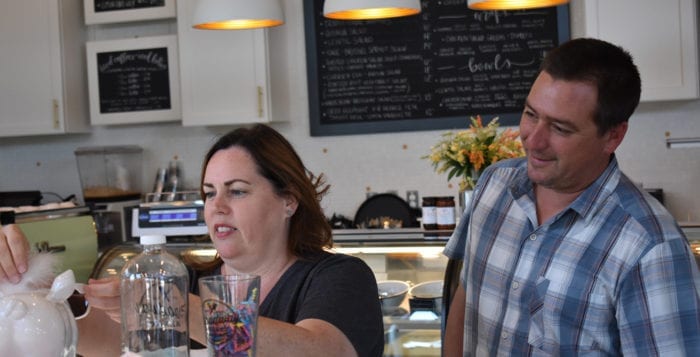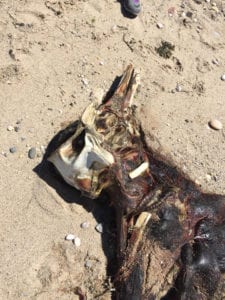The Broadway Market, a Rocky Point restaurant that opened in March, has quite a lot on its plate.
It’s not just the food — even though the restaurant has offerings not only for breakfast, lunch and dinner, but all the way through coffee, desserts and alcohol — it’s that owners Ann Olenick and Shasho Pole both respect what a place like the Broadway Market means to the community.
“I think it’s an anchor business, and I think it gives people another reason to try to come here – bringing Rocky Point back to a walking town,” Olenick said.
Olenick and Pole are both area natives, having first met at the Rocky Point Farmers & Artisan Market nearly five years ago. After learning about each other’s expertise, with Pole in the organic meats market and Olenick in baked goods and desserts, the two decided to partner up and take their show on the road. They travelled to multiple farmers markets across Long Island, and by the third year of working together the duo was going regularly to seven local markets every season.

Despite their success on the local market scene, the idea for a brick-and-mortar restaurant didn’t cross their minds until they tried to meet a demand for chicken cutlets. Because of state regulations, they could only sell chickens whole without an inspected, clean location to butcher them. Though the two looked all over Long Island for a proper space, their eyes settled on a location in Rocky Point right near the farmers market where they first met. They settled on a location that was once home to a bar, first named Harry’s Beer Garden and then Gracie’s Hearty Foods.
“It already had all the wastewater approvals, the sanitary requirements we needed and an inspected kitchen,” Pole said. “It’s funny, we went on a quest for a spot, you know a wet space, in a walking town and circuitously we wound up back here.”
The idea grew exponentially past a simple place to sell their meats and sweets. At the start of their building project they thought they could get away with a Keurig coffeemaker, but that transformed into days of barista classes in New York City. They originally didn’t think that the restaurant would have a bar, but since the location already had a liquor license they decided to go through another round of classes, this time in bartending.
“We thought we would have a little closet — a little boutique — and we wound up with all this,” Pole said.
The building sticks out not just for its looks, with modern rustic-gray stonework and barn-wood interior, but for its freshness. Local community leaders have recognized just how much of a turning point the Broadway Market is for downtown Rocky Point.
“The Broadway Market is great — it’s bringing more attention to the community,” said Charles Bevington, the president of the Rocky Point Civic Association. “Rocky Point is still a place where people can invest.”
While the old Gracie’s stood in the same spot as the market, the only things left of the building are the western wall, a chair and the beer tower, now refurbished, that used to belong to both Harry’s and Gracie’s.
Pole said that all the food at Broadway Market is as regionally sourced as possible, including fish and vegetables as long as they are in season. Some 10 percent of the meats are grass fed, particularly the beef used for burgers, and they do their best to get their chickens from free-range sources.
On the bakery side of things, Olenick, who is a college-trained pastry chef, said she offers some of her own designs along with the designs offered by their trained in-house chef Elizabeth Moore.
Though the two owners know their food, it took a bit of time for the pair to figure the ins and outs of operating a restaurant. Over the past several months they have slowly increased the number of days and hours they are open. Now as the sun rises on the restaurant, the building strikes such a distinct poise compared to the other smaller, brown and white paneled buildings it neighbors. Some locals have described it as something one would only see in more affluent areas like in the Hamptons.

“We’ve had people say when are you opening in East Hampton, when are you opening in Huntington? Can you come to Soho?” Olenick said laughing.
“Stop, stop, stop — please, we need to get our traction here first,” Pole said, continuing from where Olenick left off. “There are naysayers, but the feedback that I get here is a resounding ‘we need this, we need something like this.’”
Either way, the community is responding to the new restaurant in a big way. Some see it as a dream of what might be the future of Rocky Point’s downtown.
“It’s good to have a nice restaurant in the area,” said Kenny Kowalchuk, a Rocky Point local who had just finished his meal at the restaurant. “This is really turning the community around.”
Broadway Market is located at 643, Broadway in Rocky Point. The location is open seven days a week, Sunday 8 a.m. to 3 p.m., Monday 2 to 10 p.m. and Tuesday through Saturday 8 a.m. to 10 p.m.




 YIELD: Makes 6 servings
YIELD: Makes 6 servings













